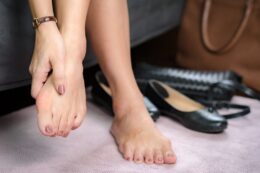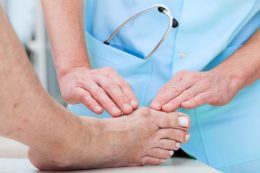Tagged with #buniontreatment …
5 Tips To Prevent Bunion Pain
Bunions occur when excessive and continuous pressure on your feet forces your big toe to point toward the rest of your foot, causing misalignment. They are characterized by a bony bump that develops outside your big toe.
Aside from the pain and soreness, having bunions may also result in corns and calluses, further affecting your daily routines. That said, it’s best to learn how to prevent and alleviate bunion pain. Here’s what you should do:
- Wear Well-Fitting Shoes
One of the major risk factors for developing bunions is wearing tight, narrow, and pointy shoes. Because of the limited space ill-fitting footwear provides, they put excess pressure on your toes and mess with their proper alignment. If you already have a bunion, wearing these shoes will not only cause pain but also worsen your condition.
Because of this, it’s crucial to get footwear with the correct size. If possible, get a pair that has a roomy toe box, good arch support, and a comfortable fit.
- Use Padding or Shoe Inserts
Another way to prevent and reduce pain from bunions is by padding or adding orthotics to your shoes. Bunion pads provide additional cushioning to prevent your affected toe from rubbing against your shoes and causing discomfort. Meanwhile, custom shoe inserts help distribute pressure evenly on your feet, minimizing pain and the progression of your foot condition. To determine which works best for you, consult a podiatrist.
- Do Bunion Exercises
Exercising regularly helps improve your feet’s strength and mobility, thus relieving and preventing bunion symptoms like soreness and pain. Some exercises you can try are toe curls, toe stretches, towel crunches, and ball rolls. You can also talk to your foot doctor to ensure your routine is safe for your condition.
- Apply Ice to the Affected Area
This is one of the easiest ways to relieve painful, swollen bunions. If you notice these symptoms, especially after standing or walking all day, apply an ice pack on your feet for at least 10 minutes or more.
- Take Pain Medications
Of course, you can always take medication when you experience pain and inflammation with your bunions. A nonsteroidal anti-inflammatory medicine like ibuprofen can work wonders to reduce these symptoms. If necessary, your foot doctor may also prescribe a corticosteroid injection.
Contact Us at Thomas Podiatry & Associates
Learning about these tips will help ease any pain and discomfort associated with bunions. If you need a routine foot check-up or professional advice on your bunion pain, consult a podiatrist. Reach out to us at Thomas Podiatry & Associates in Salisbury, MD for reliable podiatric services.
What You Need to Know About Bunions
Bunions are a common foot problem. They are a type of deformity that happens when the big toe pushes towards the other toes of the feet, causing a misalignment. This results in the formation of a bony bump on the joint at the base of your big toe.
This foot condition may cause limited movement and extreme pain, so it’s crucial to get bunion treatment after diagnosis. Read on to learn more about bunions and determine whether you are at risk of this foot problem.
What Causes Bunions?
Various factors cause bunions. They include pressure from faulty foot mechanics and foot stress or injury. Inherited foot structures, like having low arches or flat feet, also put you at risk of developing this condition. Besides that, those who have rheumatoid arthritis are more likely to develop bunions.
What Are the Symptoms of Bunions?
One of the most noticeable symptoms is the bump that forms at the side of your big toe. Besides the difficulty in fitting footwear, you may also feel pain, swelling, soreness, and numbness in the feet. Corns and calluses may also grow since the toes tend to rub against each other because of your foot’s misalignment.
Bunions develop gradually and can worsen over time. Standing for long periods and wearing ill-fitting shoes are some factors that can worsen its symptoms.
How Are Bunions Treated?
Various treatments help manage and remedy bunions, depending on your condition. Some non-invasive procedures include medication, footwear modification, taping and padding, orthotic devices, and physical therapy.
If these don’t work and your condition becomes severe, your foot doctor may recommend surgery. You will need to undergo an operation where the bunion is removed, and your bones are realigned to their correct positions.
Contact Thomas Podiatry & Associates
Bunions, if not treated right away, can lead to more serious complications. They include bursitis, where the bursa that cushions the bones near your joints becomes inflamed, and metatarsalgia, which causes pain and swelling in the ball of the foot. So, if you notice early signs, talk to a foot doctor right away. For reliable bunion treatment in Salisbury, MD reach out to Thomas Podiatry & Associates. Our team of experts will gladly assist you with your podiatric needs.







